Norwegian forest (English: Norwegian forest, CAT, NFO) is a cat breed that resembles the European shorthair in its body proportions. However, it has one feature — long water-repellent fur that dries very quickly after rain.
History
Despite the name, this cat has always been domestic. She got her name, probably, for her free behavior and love of freedom. Its origin is unknown, probably the breed comes from short-haired European and long-haired Asian cats brought by merchants to Northern Europe. In 1977, the breed was recognized by the International Federation of European Cat Fanciers (FIFE). The breed is mainly distributed in Europe.
Nature
The Norwegian forest cat is a strong, sturdy animal. Willingly catches mice, active, mobile. Can live indoors, but likes to spend time outdoors. The animal is free-loving, with a cool and firm character, but it is easy to win its favor. She loves the company of people.
Peculiarities of reproduction
Kittens are born strong and healthy. An adult coat first appears at the age of 3 to 5 months. The Norwegian Forest Dog is a slow-growing breed, reaching full development at around 5 years of age.
Appearance
The Norwegian Forest Dog gives the impression of a well-built, strong animal with well-developed musculature. The body is quite long, proportional, strong, massive. The bone is strong with a well-developed chest. The body has a deep crotch line. Chest and shoulders are well developed. A cat is much bigger than a cat. The limbs are strong, high, the hind legs are higher than the front, which makes the pelvis higher than the shoulders. Thighs are muscular, front legs are strong. If you look from behind, the limbs will seem straight. On the front legs, the toes are turned outwards. The paws are large, rounded, heavy in appearance, with strands of fur between the toes. The tail is long, wide at the base, fluffy, covered with long hair that covers the hind limbs (long covering hair - "peacock tail" is preferred). It can reach the shoulders, but it is desirable that its length is equal to the length of the body from the base of the tail to the neck.
The head is an equilateral triangle, all sides of which are equal to the distance between the outer point of the base of the ear and the chin. The forehead is almost flat, only slightly rounded. The nose is straight, wide, long, without a saddle. The cheekbones are well developed. The mustache sticks out to the sides. The chin is strong, heavy, on the same line as the nose. It gently fits into the profile. Cheeks are full. Ears are medium to large in size, wide at the base, erect, pointed at the ends. Located high on the top, widely spaced. The auricle is slightly expanded outwards. The outer edge of the ear forms a straight line with the edge of the cheek. The outer line of the ear continues the line of the head from the chin. Tassels on the tips of the ears and long strands of hair growing from the ears are desirable. The eyes are large, oval, expressive, obliquely set. The outer corner of the eye is higher than the inner corner. Any color that matches the color of the fur is allowed. The neck is short, muscular.
The fur is long, smooth, close to the body. The structure is double, consisting of a thick undercoat, covered with shiny, smooth, water-repellent bristly hair that hangs down, covers the back and sides. The fully "dressed" cat has a mane on the neck, sideburns and a long bib. The collar consists of three separate parts: a short mane on the neck, sideburns (fur on the cheeks), a long front bib. Well-developed "pants" on the hind legs. There is no bristly fur on the back of the "pants" because they are covered by a long tail fur. Fur is usually thicker in winter than in summer, because the undercoat is better developed in winter. The collar falls out in the summer and grows back in the fall. Shaded, single-toned and bi-colored dogs have softer fur than tabby dogs. The quality of fur depends on living conditions: cats that spend most of their time indoors have shorter and softer fur. When evaluating a coat, type and quality are the primary characteristics, and color and pattern are secondary.
Color
All colors are allowed, including all colors with white, except Himalayan, chocolate, mauve or combinations thereof with white. Any amount of white in the coloring is acceptable (white flame, white medallion, white breast, white belly, white paws, etc.). The drawing of the tabby should be clear and expressive, characteristic classic (marble), mackerel, spotted or with ticking. According to the FIFE standard, 4 groups of animals are distinguished by color: with agouti factor, without agouti factor, with agouti factor with white, without agouti factor with white. The color of the eyes should match the color of the fur. The lobe of the nose and the pads of the paws have a color that matches the color of the fur. Cats with agouti factor have a bordered nose lobe.
#NorwegianForestCat#catstalker#cat'sfeelings
History
Despite the name, this cat has always been domestic. She got her name, probably, for her free behavior and love of freedom. Its origin is unknown, probably the breed comes from short-haired European and long-haired Asian cats brought by merchants to Northern Europe. In 1977, the breed was recognized by the International Federation of European Cat Fanciers (FIFE). The breed is mainly distributed in Europe.
Nature
The Norwegian forest cat is a strong, sturdy animal. Willingly catches mice, active, mobile. Can live indoors, but likes to spend time outdoors. The animal is free-loving, with a cool and firm character, but it is easy to win its favor. She loves the company of people.
Peculiarities of reproduction
Kittens are born strong and healthy. An adult coat first appears at the age of 3 to 5 months. The Norwegian Forest Dog is a slow-growing breed, reaching full development at around 5 years of age.
Appearance
The Norwegian Forest Dog gives the impression of a well-built, strong animal with well-developed musculature. The body is quite long, proportional, strong, massive. The bone is strong with a well-developed chest. The body has a deep crotch line. Chest and shoulders are well developed. A cat is much bigger than a cat. The limbs are strong, high, the hind legs are higher than the front, which makes the pelvis higher than the shoulders. Thighs are muscular, front legs are strong. If you look from behind, the limbs will seem straight. On the front legs, the toes are turned outwards. The paws are large, rounded, heavy in appearance, with strands of fur between the toes. The tail is long, wide at the base, fluffy, covered with long hair that covers the hind limbs (long covering hair - "peacock tail" is preferred). It can reach the shoulders, but it is desirable that its length is equal to the length of the body from the base of the tail to the neck.
The head is an equilateral triangle, all sides of which are equal to the distance between the outer point of the base of the ear and the chin. The forehead is almost flat, only slightly rounded. The nose is straight, wide, long, without a saddle. The cheekbones are well developed. The mustache sticks out to the sides. The chin is strong, heavy, on the same line as the nose. It gently fits into the profile. Cheeks are full. Ears are medium to large in size, wide at the base, erect, pointed at the ends. Located high on the top, widely spaced. The auricle is slightly expanded outwards. The outer edge of the ear forms a straight line with the edge of the cheek. The outer line of the ear continues the line of the head from the chin. Tassels on the tips of the ears and long strands of hair growing from the ears are desirable. The eyes are large, oval, expressive, obliquely set. The outer corner of the eye is higher than the inner corner. Any color that matches the color of the fur is allowed. The neck is short, muscular.
The fur is long, smooth, close to the body. The structure is double, consisting of a thick undercoat, covered with shiny, smooth, water-repellent bristly hair that hangs down, covers the back and sides. The fully "dressed" cat has a mane on the neck, sideburns and a long bib. The collar consists of three separate parts: a short mane on the neck, sideburns (fur on the cheeks), a long front bib. Well-developed "pants" on the hind legs. There is no bristly fur on the back of the "pants" because they are covered by a long tail fur. Fur is usually thicker in winter than in summer, because the undercoat is better developed in winter. The collar falls out in the summer and grows back in the fall. Shaded, single-toned and bi-colored dogs have softer fur than tabby dogs. The quality of fur depends on living conditions: cats that spend most of their time indoors have shorter and softer fur. When evaluating a coat, type and quality are the primary characteristics, and color and pattern are secondary.
Color
All colors are allowed, including all colors with white, except Himalayan, chocolate, mauve or combinations thereof with white. Any amount of white in the coloring is acceptable (white flame, white medallion, white breast, white belly, white paws, etc.). The drawing of the tabby should be clear and expressive, characteristic classic (marble), mackerel, spotted or with ticking. According to the FIFE standard, 4 groups of animals are distinguished by color: with agouti factor, without agouti factor, with agouti factor with white, without agouti factor with white. The color of the eyes should match the color of the fur. The lobe of the nose and the pads of the paws have a color that matches the color of the fur. Cats with agouti factor have a bordered nose lobe.
#NorwegianForestCat#catstalker#cat'sfeelings
- Catégories
- Chats de Race European Shorthair
- Mots-clés
- Norwegian Forest Cat, cat stalker, cat's feelings







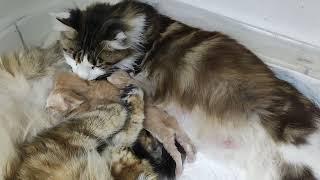
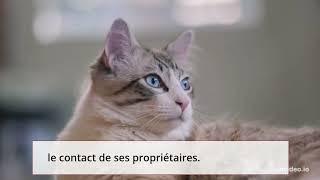
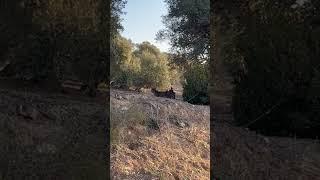
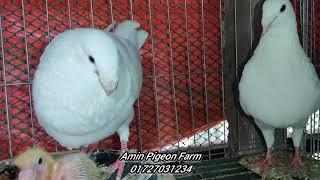
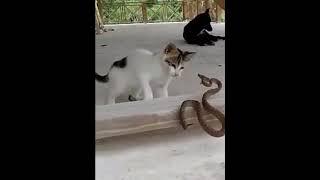
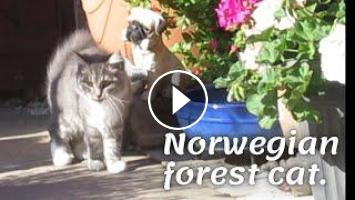

Commentaires